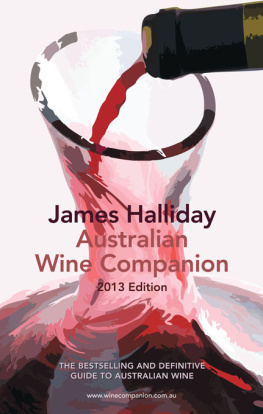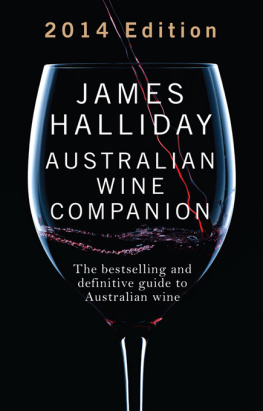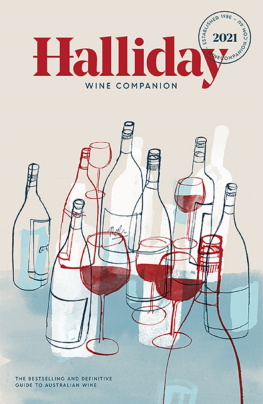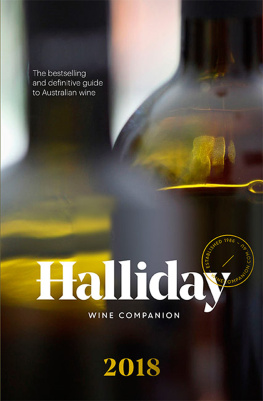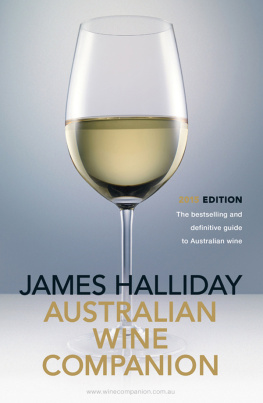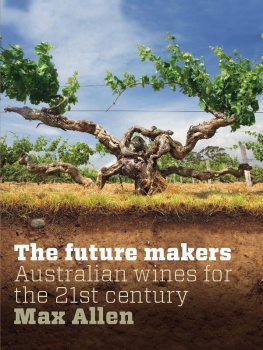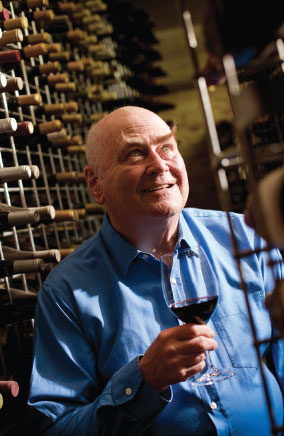About the author
Respected wine critic and vigneron James Halliday AM has a career that spans over forty years, but he is most widely known for his witty and informative writing about wine. As one of the founders of Brokenwood in the Lower Hunter Valley, New South Wales, and thereafter of Coldstream Hills in the Yarra Valley, Victoria, James is an unmatched authority on every aspect of the wine industry, from the planting and pruning of vines through to the creation and marketing of the finished product. His winemaking has led him to sojourns in Bordeaux and Burgundy, and he has had a long career as a wine judge in Australia and overseas. In 1995 he received the wine industrys ultimate accolade, the Maurice OShea Award.
James has written or contributed to more than 65 books on wine since he began writing in 1979. His books have been translated into Japanese, French, German, Danish, Icelandic and Polish, and have been published in the UK and the US, as well as in Australia. He is the author of JamesHallidays Wine Atlas of Australia and The Australian Wine Encyclopedia. In 2010 James was made a Member of the Order of Australia.
I make my usual disclaimer: while there are two periods of intense tasting activity in the 12 months during which the tasting notes for this edition were made, and while some wines are tasted more than once, an over-arching comparative tasting of all the best wines is simply not possible, however desirable it might be.
So the points for the individual wines scoring 94 or above stand uncorrected by the wisdom of hindsight. Nonetheless, the link between variety and region (or, if you prefer, between variety and terroir) is in most instances strikingly evident. It is for this reason that I have shown the region for each of the best wines. Medium and longer term prosperity will depend on a sense of place, of regional identity. It is also the reason for the overview of the .
Brand Australia has been the foundation upon which the success of the past 20 years has been built, but all recognise the need to move on. While some naysayers may regard this as marketing rhetoric, the truth is that Australia is blessed with an unmatched range of terroir (including climate in that deceptively simple term) enabling it to make wines ranging from the uniquely complex fortified wines of Rutherglen (fashioned from frontignac and muscadelle, known locally as muscat and tokay), to the 100-year-old Para Liqueur of Seppelt in the Barossa Valley, all the way through to the exceptional sparkling wines of Tasmania, grown in a climate every bit as cool as that of Champagne.
This is one of the principal reasons for the wines with the same points to be arranged by region, even though the main text is alpha-ordered. I should also point out that the cut-off for listing the wines of each variety differs considerably, depending on the strength of the class concerned.
There is now a second string to the bow of exports: Australia+ Australian Wine (www.apluswines.com). It is a reflection of two realities. First, the honeymoon days of ever-rising value and volume exports year-on-year are for a variety of short and longer term reasons are gone forever. Second, it is essential that far more focus is directed on the type of wines that follow over the next 18 pages if exports are to reach their full potential.
Riesling
These wines show that the Clare and Eden Valleys remain at the head of the regional pack, but the regions of South West Australia and Tasmania are nipping at their heels. Only three other regions contribute (in a small but impressive way) to the mix: Canberra District, Henty and Grampians.
| RATING | WINE | REGION |
| 97 | 2011 Grosset Polish Hill | Clare Valley |
| 97 | 2011 Wines by KT Melva Wild Fermented | Clare Valley |
| 97 | 2011 Bests Great Western | Grampians |
| 97 | 2011 Seppelt Drumborg Vineyard | Grampians |
| 97 | 2011 Crawford River | Henty |
| 97 | 2006 Pressing Matters R9 | Southern Tasmania |
| 96 | 2011 Clonakilla | Canberra District |
| 96 | 2011 Gallagher | Canberra District |
| 96 | 2011 Atlas 172 Watervale | Clare Valley |
| 96 | 2007 Leasingham Classic Clare | Clare Valley |
| 96 | 2001 Taylors Bottle Aged St Andrews | Clare Valley |
| 96 | 2011 Henschke Julius | Eden Valley |
| 96 | 2011 Rolf Binder Veritas | Eden Valley |
| 96 | 2011 Seppeltsfield | Eden Valley |
| 96 | 2011 Tim Smith | Eden Valley |
| 96 | 2011 Frankland Estate Netley Road Vineyard | Frankland River |
| 96 | 2011 Howard Park Porongurup | Great Southern |
| 96 | 2011 Castle Rock Estate | Great Southern |
| 96 | 2011 Dukes Vineyard Magpie Hill Reserve | Great Southern |
| 96 | 2011 Dukes Vineyard Porongurup | Great Southern |
| 96 | 2011 Larry Cherubino Cherubino Porongurup | Great Southern |
| 96 | 2011 Bay of Fires | Northern Tasmania |
| 96 | 2009 Hardys HRB | Pemberton/Adelaide Hills |
| 96 | 2011 Leo Buring Leopold Derwent Valley | Tasmania |
| 96 | 2010 Pressing Matters R9 | Tasmania |
| 96 | 2011 Stefano Lubiana | Tasmania |
| 96 | 2011 Third Child Ella Mae | Tasmania |
Chardonnay
Chardonnay is a marvellously flexible variety, performing well almost everywhere it is grown. But four regions stand apart, in alpha order, Adelaide Hills, Margaret River, Mornington Peninsula and Yarra Valley. It is strongly arguable modern Australian chardonnay is our best varietal wine.
| RATING | WINE | REGION |
| 98 | 2010 By Farr | Geelong |
| 97 | 2010 Giaconda | Beechworth |
| 97 | 2010 Marchand & Burch Porongurup | Great Southern |
| 97 | 2009 Cullen Kevin John | Margaret River |
| 97 | 2010 Cullen Kevin John | Margaret River |
| 97 | 2009 Devils Lair 9th Chamber | Margaret River |
| 97 | 2009 Leeuwin Estate Art Series | Margaret River |
| 97 | 2010 Xanadu Reserve | Margaret River |
| 97 | 2010 Galli Estate Pamela | Sunbury |
| 97 | 2010 Heemskerk Coal River Valley | Tasmania |
| 96 | 2011 Casa Freschi Altezza | Adelaide Hills |
| 96 | 2010 Grosset Piccadilly | Adelaide Hills |
| 96 | 2010 Penfolds Reserve Bin A | Adelaide Hills |
| 96 | 2009 Penfolds Yattarna | cool climate blend |
| 96 | 2009 Petaluma Tiers Piccadilly Valley | Adelaide Hills |

